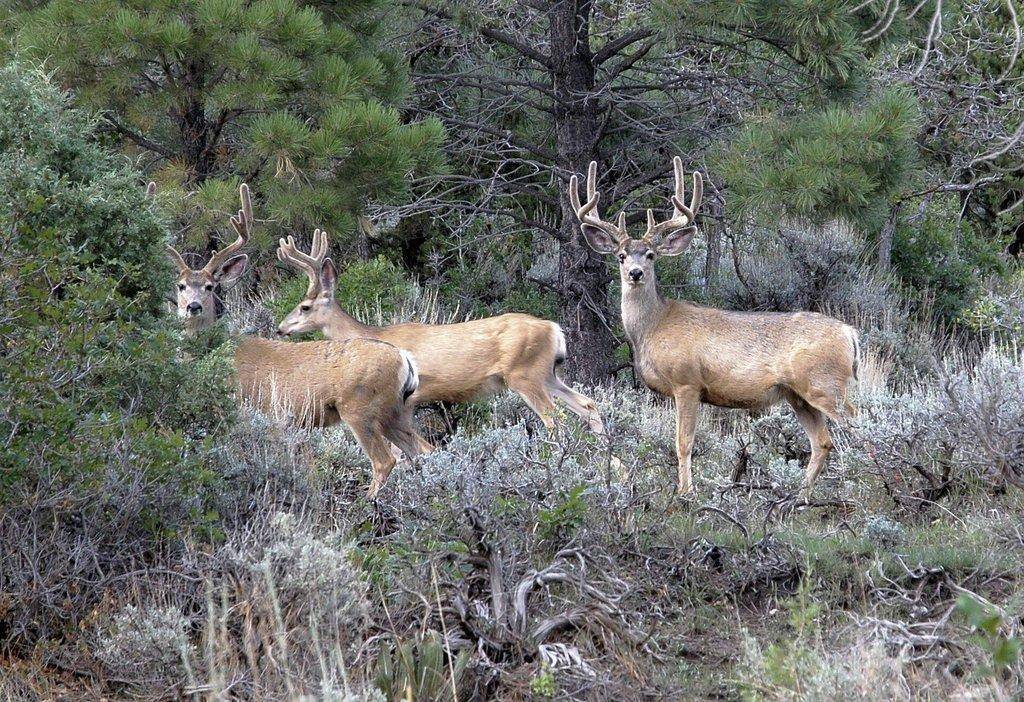If you don’t have a permit to hunt during Utah’s general archery elk hunt, you’re in luck — there’s no limit on the number of general archery elk permits the Division of Wildlife Resources can offer. So there’s no problem getting one.
You can buy a general archery elk permit at www.wildlife.utah.gov, at DWR offices and from more than 300 hunting license agents across Utah.
What can hunters expect?
Utah’s general archery elk hunt and general archery deer hunt start on Aug. 20. The two hunts are the first general hunts to be held in the state this fall.
Anis Aoude, big game coordinator for the DWR, provides the following preview for each hunt:
Archery elk
The number of elk in Utah is up. Based on surveys conducted after the fall 2010 elk hunt was over, biologists estimate the total number of elk in Utah at more than 72,500 animals.
That’s almost 4,000 more elk than the statewide objective of 68,825. “Utah’s elk herds are doing great,” Aoude says.
If you buy a general archery elk permit, you can take a bull elk or a cow elk on any general season area except the Monroe unit in southwestern Utah. On the Monroe unit, general archery elk hunters may not take a cow elk.
Plenty of bull and cow elk will be available, but taking one with a bow and arrow can be a challenge — in 2010, only seven percent of the general archery elk hunters took an animal.
To increase your chance for success, Vance Mumford, a DWR biologist in southern Utah, encourages you to remember that elk are very mobile. “Once the hunt starts,” Mumford says, “the animals seem to know they’re the focus of interest, and they seek areas where they will not be disturbed.”
To take an elk, Mumford says you should get away from roads and main trails. “During the archery hunt,” he says, “the elk will seek out thick and out-of-the-way conifers and aspen stands where they feel secure and where they can escape the summer heat.”
Archery deer
The number of buck deer compared to the number of doe deer in Utah is good across most of the state. Aoude says this past winter was a good one for deer across most of Utah.
“Even though the state received a lot of snow,” Aoude says, “temperatures across most of Utah were mild enough that the snow melted quick on the lower elevation areas where the deer spend the winter.
“Most of the fawns that were born in 2010 made it through the winter,” he says. “These deer will be available to hunters as yearling bucks this fall.”
Aoude says there are some exceptions, though — portions of the Cache unit in northern Utah, and units along the south slope of the Uinta Mountains in northeastern Utah, were hit with cold temperatures at the start of winter. The cold temperatures remained through most of the season.
“The snow in these areas crusted over and stayed that way through most of the winter,” Aoude says. “Quite a few fawns died.”
Another area of concern is southern Utah, where a severe drought several years ago has kept the overall number of deer down. “The number of fawns born in the southern part of the state has been fairly low over the past few years,” Aoude says. “Hopefully, the wet winter and spring this year will help the vegetation. If the vegetation improves, so will the overall number of deer.”
Bucks per 100 does
Every fall — after the archery, muzzleloader and rifle hunts are over and while the deer are grouped together during their breeding period — DWR biologists conduct deer surveys.
During the surveys, the biologists compare the number of bucks they see to the number of does they see. The chart below shows what the biologists found. The chart lists the number of bucks per 100 does:
RegionВ В В В В В 2008В В В 2009В В В 2010В В В Three-year average
NorthernВ В В В В В 15В В В 18В В В 22В В В 18
CentralВ В В В В В 17В В В 16В В В 18В В В 17
NortheasternВ В В В В В 15В В В 15В В В 18В В В 16В В В
SoutheasternВ В В В В В 17В В В 15В В В 14В В В 16
SouthernВ В В В В В 19В В В 18В В В 16В В В 18
Southeastern Region
Brent Stettler, Southeastern Region conservation outreach manager, provides the following report for different parts of the Southeastern Region:
Northern part of region
Deer hunting in the northern part of the region should be slightly better than last year, due to increased fawn production last summer and higher fawn-to-doe ratios last fall. Southeastern Utah experienced a relatively mild winter in 2010 – 2011, which promoted better than average fawn survival.В Last year’s fawns will be yearlings when the archery hunting season starts.В And yearling bucks make up the majority of the harvest in the northern part of the region.
Southern part of the region
Deer hunting on these units should be similar to that experienced by hunters last year. However, last year’s deer hunting success was down from previous years, partly because of the hard winter of 2009 – 2010.В Fawn-to-doe ratios were below average last summer and fall on these units, which will result in fewer bucks for hunters this fall.
Across the region
Abundant summer rainfall may result in greater dispersion of deer. Hunters may have to cover more territory than they’ve had to cover in past years. Sources of water will be more widespread, which might be challenging for those who prefer to hunt over water holes. Archers are encouraged to do pre-season scouting to locate a shootable buck and to pattern his movements and behavior.

